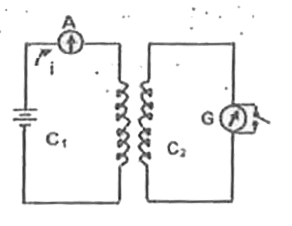An ammeter and a milliammeter are converted from identical galvanometers. Which one has smaller resistance ?
Ammeter
Milliammeter
Both have equal resistances
The resistance of ammeter may be more than or equal to that of milliammeter depending upon its range.
The correct Answer is:A
To determine which device, an ammeter or a milliammeter, has smaller resistance when both are converted from identical galvanometers, we can analyze the relationship between current and resistance.
1. Understanding the Devices:
- An ammeter is designed to measure larger currents (in amperes).
- A milliammeter is designed to measure smaller currents (in milliamperes).
2. Ohm's Law:
- According to Ohm's Law, the relationship between voltage (V), current (I), and resistance (R) is given by the formula:
V=I×R
- Rearranging this gives:
I=VR
- This indicates that current (I) is inversely proportional to resistance (R).
3. Current Ranges:
- Since an ammeter measures larger currents, it operates at a higher current level compared to a milliammeter, which measures smaller currents.
- Therefore, we can say:
- Iammeter>Imilliammeter
4. Resistance Comparison:
- From the relationship I=VR, if the current is higher (as in the case of the ammeter), the resistance must be lower.
- Conversely, if the current is lower (as in the case of the milliammeter), the resistance must be higher.
5. Conclusion:
- Since the ammeter has a higher current, it has a lower resistance compared to the milliammeter.
- Therefore, the ammeter has smaller resistance than the milliammeter.
Final Answer:
The ammeter has smaller resistance than the milliammeter.
- An ammeter is designed to measure larger currents (in amperes).
- A milliammeter is designed to measure smaller currents (in milliamperes).
- According to Ohm's Law, the relationship between voltage (V), current (I), and resistance (R) is given by the formula:
V=I×R
- Rearranging this gives:
I=VR
- This indicates that current (I) is inversely proportional to resistance (R).
- Since an ammeter measures larger currents, it operates at a higher current level compared to a milliammeter, which measures smaller currents.
- Therefore, we can say:
- Iammeter>Imilliammeter
- From the relationship I=VR, if the current is higher (as in the case of the ammeter), the resistance must be lower.
- Conversely, if the current is lower (as in the case of the milliammeter), the resistance must be higher.
- Since the ammeter has a higher current, it has a lower resistance compared to the milliammeter.
- Therefore, the ammeter has smaller resistance than the milliammeter.
The ammeter has smaller resistance than the milliammeter.
Topper's Solved these Questions
- BOOK - AAKASH INSTITUTE ENGLISHCHAPTER - CURRENT ELECTRICITYEXERCISE - ASSIGNMENT SECTION-C(OBJECTIVE TYPE QUESTION ))13videos
CURRENT ELECTRICITY
- BOOK - AAKASH INSTITUTE ENGLISHCHAPTER - CURRENT ELECTRICITYEXERCISE - ASSIGNMENT SECTION-D( LINKED COMPREHENSION TYPE QUESTIONS)3videos
CURRENT ELECTRICITY
- BOOK - AAKASH INSTITUTE ENGLISHCHAPTER - CURRENT ELECTRICITYEXERCISE - ASSIGNMENT(SECTION-A(OBJECTIVE TYPE QUESTIONS))69videos
CURRENT ELECTRICITY
- BOOK - AAKASH INSTITUTE ENGLISHCHAPTER - COMMUNICATION SYSTEMS EXERCISE - ASSIGNMENT SECTION D (Assertion-Reason)10videos
COMMUNICATION SYSTEMS
- BOOK - AAKASH INSTITUTE ENGLISHCHAPTER - DUAL NATURE OF RADIATION AND MATTER EXERCISE - ASSIGNMENT (SECTION-D)10videos
DUAL NATURE OF RADIATION AND MATTER
Similar Questions
The ammeter (A) and voltmeter (V) in the given circuit are ideal but the galvanometer has a resistance of 2Ω In steady state
 View Solution
View Solution(a) Briefly explain how a galvanometer is converted into an ammeter.
(b) A galvanometer coil has a resistance of 15Ω and it shows full scale deflection for a current of 4 mA. Convert it into an ammeter of range 0 to 6 A.View Solution
Knowledge Check
- Question 1 - Select One
A galvanometer can be converted into an ammeter by connecting
Alow resistance In parallelBlow resistance In seriesChigh resistance In parallelDhigh resistance In series
State how a moving coil galvanometer can be converted into an ammeter.
View SolutionTwo identical galvanometers are converted into an ammeter and a milliammeter. If the shunt, which has more resistance, the current passing through the coil will be
View Solution(A) : If a galvanometer is converted into an ammeter and a milliammeter then the shunt resistance of ammeter is lower than that of milliammeter.
(R) : In Ammeter the current through shunt is less than that of galvonameter as compared to the case of milliammeter.View SolutionA galvanometer is to be converted into an ammeter or voltmeter. In which of the following cases the resistance of the device is largest?
View SolutionA galvanometer is to be converted into an ammeter or voltmeter. In which of the following cases the resistance of the device is largest?
View SolutionA galvanometer (coil resistance 99Ω.) is converted into an ammeter using a shunt of 1Ω and connected as shown in figure (a). The ammeter reads 3A. The same galvanometer is convened into a voltmeter by connecting a resistance of 101Ω in series. This voltmeter is connected at, shown in figure (b). Its reading is found to be 45 of the full scale reading. Find :
(a) internal resistance r of the cell
(b) range of the ammeter and voltmeter
(c) full scale deflection current of the galvanometer.
 View Solution
View SolutionIn figure when key is pressed the ammeter A reads i ampere . The charge passing in the galvanometer circuit of total resistance R is Q . The mutual inductance of the two coils is
 View Solution
View Solution

